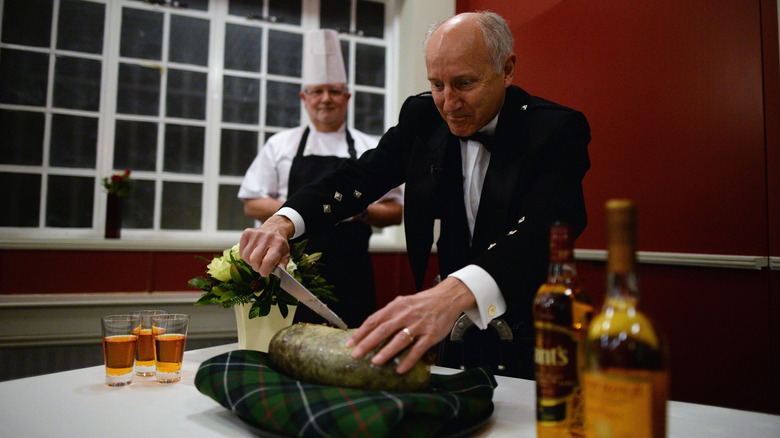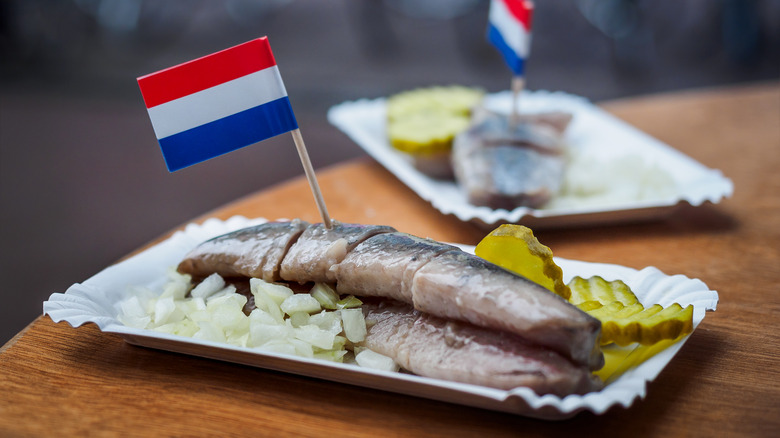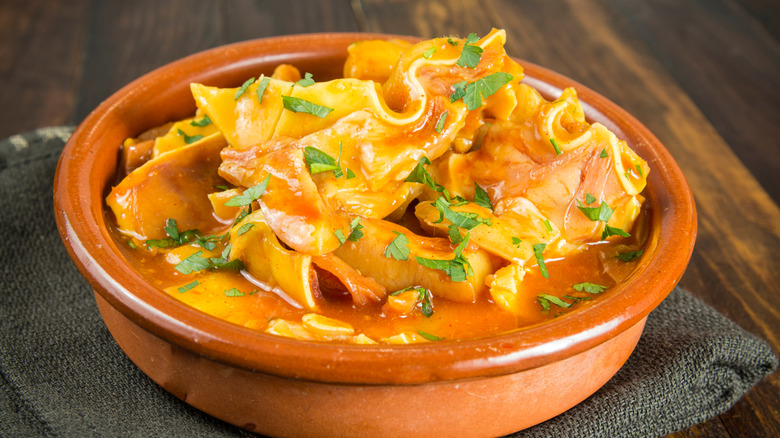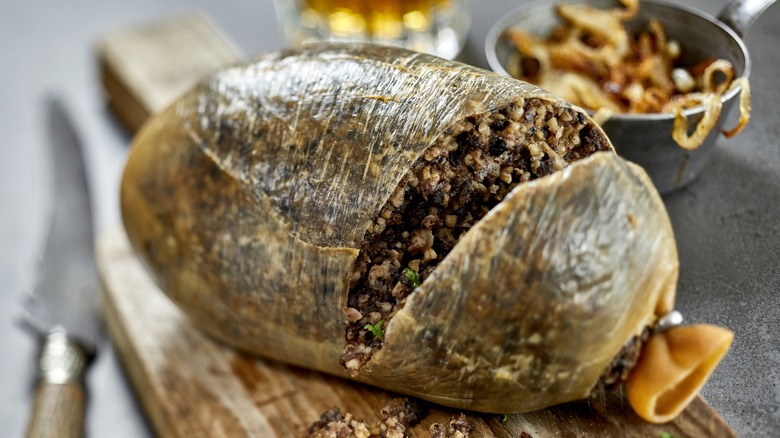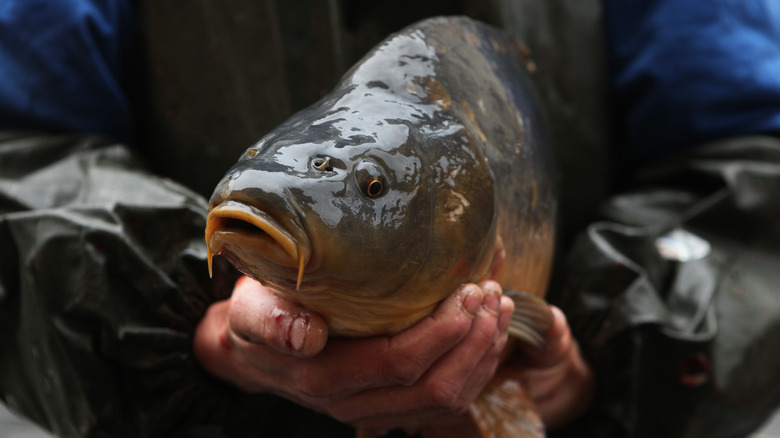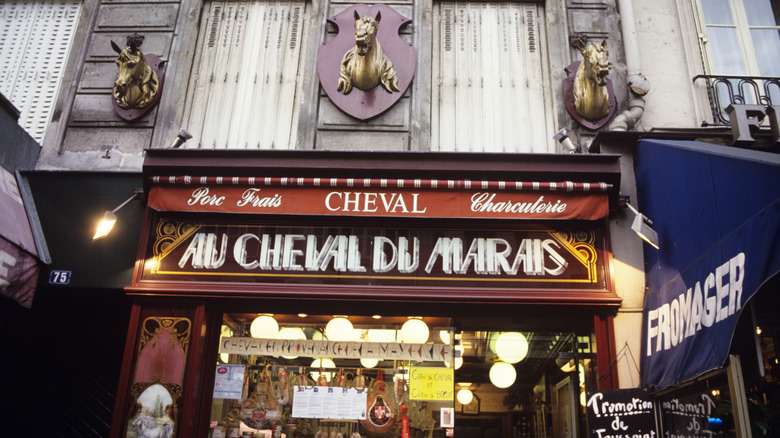Europe's Most 'Offbeat Delicacies' For An Adventurous Foodie's Bucket List, Per Rick Steves
Forget the landmark sights, the art galleries, and the museums: People are what they eat, and the best way to discover a country's soul is through its food. If you can avoid the tourist trap restaurants and resist the allure of McDonald's, tucking into regional delicacies in places frequented by the locals is a sure-fire way to get a true taste of a destination. Rick Steves regularly stresses this point in his writing and travel shows, and trying out some more unusual dishes that might be hard to find, or even illegal, back home is what he calls "sightseeing for the palate," per his website.
Sure, you can (and probably should) check out the usual culinary suspects. No doubt you'll want to find out why fish and chips are so popular in the U.K. and eat pizza Neapolitan-style in Italy. A visit to France wouldn't be complete without munching on a fresh baguette, perhaps with some fine ham and good quality butter for a classic jambon-buerre, and one of the best ways to mingle in Germany is to join the queue at a cherished currywurst stand. But if you want to delve deeper into a country's cuisine, you may want to follow Steves' advice and sample dishes that might seem weird to you at first glance. Weirdness is in the tastebuds of the diner, so let's keep an open mind and look at some of his offbeat suggestions for the adventurous foodie on the road in Europe.
Pickled herring is a popular Dutch dish
Artifical refrigeration wasn't invented until the mid-1700s, so unless you were rich and could afford your own ice house, you had to find other ways to preserve perishable foods. When it came to meat and fish, curing or fermenting was often the way to go. Many seafaring European countries developed these practices as the demand for fish grew at home and abroad, including the Netherlands. We don't need to do that to our food so much now, but a taste for preserved fish is still deeply ingrained in some cultures.
Pickled herring is a Dutch favorite dating back more than a thousand years to the advent of commercial fishing, and it's something worth attempting on a day trip to Amsterdam. Many locals enjoy popping out for a bite of the fish from herring stalls (haringkar), where it is typically served with raw onions and pickles. The traditional method of consuming the delicacy is to tip one's head back and lower the whole thing into your mouth, but you can cut it up if you prefer small bites. What does it taste like? Per Rick Steves: "It's salty."
Fermented and cured fish are also popular in Scandinavian countries. Norwegian lutefisk, which Steves regards as "inedible," is dried cod or other whitefish cured in lye and water. This becomes a jelly-like substance that is often served with boiled potatoes and white sauce, and it's a Christmas tradition in Norway.
Pig ears are a chewy snack in Spain
In some parts of the United States, snacking on pig ears is usually thought of as something that dogs enjoy; the chewy treats keep them occupied and stimulates their brain. It's not just pet pooches who like to nibble on porcine cartilage, however. Pig Ears are common in many international cuisines from Asia to Europe and are even considered a soul-food classic in some southern states. People have been eating them for centuries, when we were more inclined to eat every edible part of an animal before we could afford to be picky with our cuts. In recent years, nose-to-tail dining has become a more ethical approach to eating meat, and pig ears have even become trendy as some modern restaurants have turned this unexpectedly delicious part of the pig into something hip.
In Spain, pig ears find their way into tapas. Oreja a la plancha is a traditional snack in Madrid, where grilled pieces of pig ear are often served with mushrooms, bacon, and a squeeze of lemon. In Basque Country, it becomes a more saucy dish with the accompaniment of salsa Vizcaina, cooked with onions, garlic, and red peppers. Locals love them for the chewy texture of the skin contrasted with a nice bit of cartilage crunch, washed down with an ice cold beer. Over in the underrated Spanish region of Galicia, the ears may also be served just plain and boiled.
Animal organs are offal-ly good in some countries
Offal is something that tends to upset the squeamish. Collectively, it's the bits of a slaughtered animal that those with a sensitive stomach often shy away from, including organs like liver, intestines, lungs, sweetbreads, heart, and brains. While these cuts have acquired an unfavorable stigma in the United States, many countries in Europe still cook up a variety of dishes using these supposedly less-appealing morsels.
Perhaps the most well known is Scottish haggis. Traditional haggis includes chopped up sheep's offal mixed with onions, oatmeal, suet (crumbly beef fat), spices, and seasoning, all stuffed into a sheep's stomach. It's eaten all year round, but it is famously served on Burns Night with neeps and tatties (mashed turnips and mashed) and a dram of whisky. Some modern versions are made with an artificial casing rather than a real stomach.
In Rome, the offal and entrails make up the "fifth quarter" of a slaughtered animal. Once the food of the impoverished, these lesser cuts eventually became a fundamental part of Roman cooking. Nowadays, family-run restaurants across the city still serve up dishes involving oxtail (coda alla vaccinara); lamb liver, heart, and lungs (coratella); and brain (cervella), among others.
Meanwhile in Turkey, kokoreç is a popular dish made from lamb sweetbreads wrapped in intestines with spices and roasted on a spit over coals. It's best eaten as street food, chopped up and stuffed into bread.
Czechs love carp and smelly cheese
While families in the United States and Britain are carving up a turkey for Christmas dinner, the Czechs are usually tucking into their traditional meal of fried carp with potato salad. You'll see tubs of live carp at market places, and some Czechs still like to keep their fish swimming in their bathtub before slaughtering it for the feast.
Carp is an acquired taste for some visitors, but the landlocked Czechs have been breeding the bottom feeders for centuries in both natural and artificial ponds. Little of the fish goes to waste as almost every part finds its way into traditional recipes, including the sex organs and their contents. In some places, the sperm is fried up for a tapas-style nibble, sometimes served with potatoes. Rick Steves stumbled upon this unusual delicacy in the Třeboň region, a part of the Czech Republic that has a long association with carp breeding dating back to the 14th century.
A more common Czech snack that Steves also mentions is a smelly curd cheese called olomoucké tvarůžky. It looks a little like half-melted candle wax and even the Czechs have a love-or-hate relationship with it, largely thanks to its pungent foot-like odor. There are many ways to prepare the cheese, but it is often found sitting on the counter at room temperature in more old-school pubs around the country. Served on local bread with raw onions, it goes down like a treat with an excellent Czech beer.
Controversial French eats
Attitudes toward what it is appropriate to eat can change from country to country, and sampling food that is okay in one place but taboo in your home country comes down to personal moral standards. Rick Steves talks about eating two controversial French delicacies: horse meat and foie gras.
Horse meat was once illegal in France, but it was eaten out of revolutionary zeal and wartime necessity in the 18th and 19th centuries, with sale of equine flesh legalized in 1866. Nowadays, far fewer French people are buying or eating horse meat than in the past century, and horse butchers (boucherie chevaline) are becoming a rare trade in the country.
Foie gras, or fattened goose liver, is banned is several countries, but it is still considered fine gourmet eating in France. The French eat most of the world's foie gras, and around 90% is produced in the Dordogne region of the country. The process of force-feeding geese to enlarge their livers is considered cruel and inhumane by many animal rights groups and their supporters. If you decide to put your scruples to one side on your next trip to France, it is a delicious luxury item that is often cooked whole, sliced, or incorporated into rich pâté and mousses.
